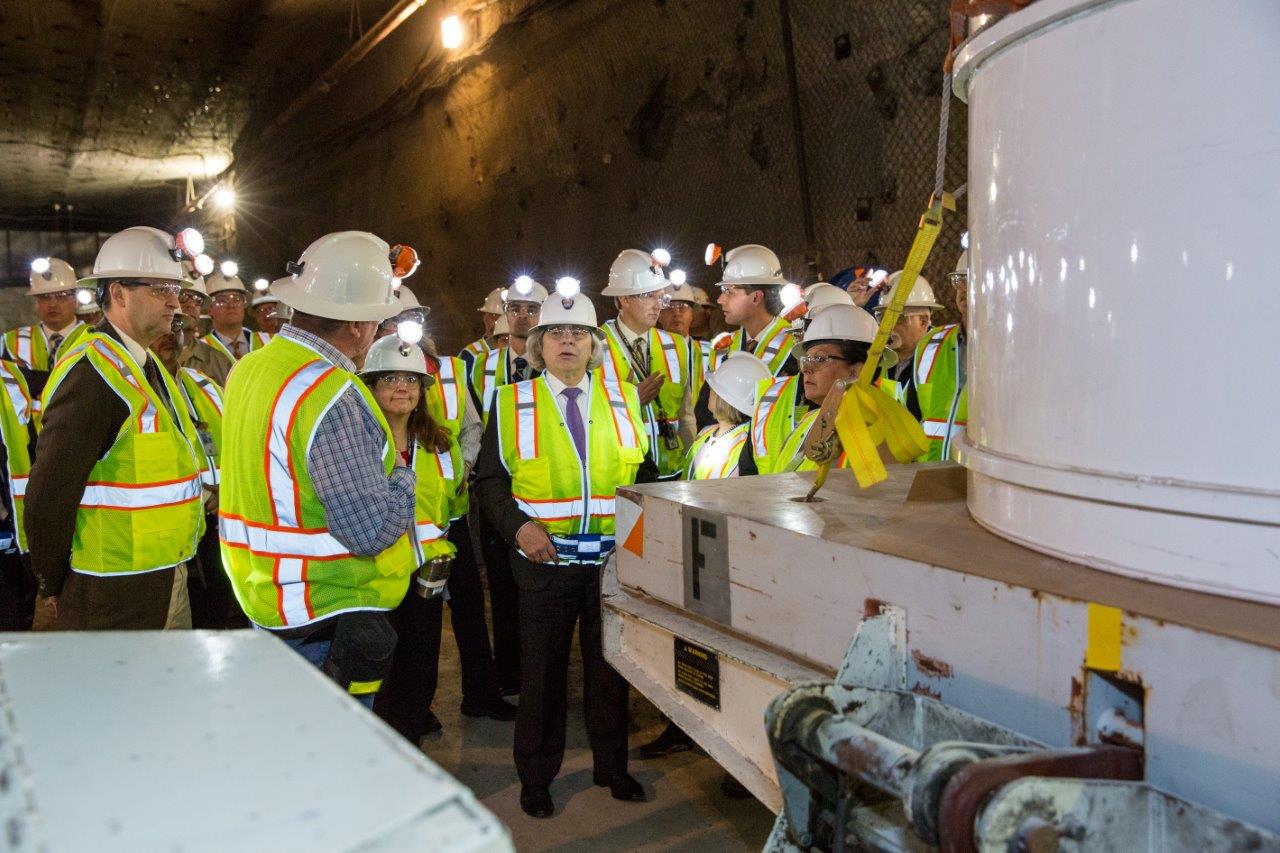
CARLSBAD, N.M. — Energy Secretary Ernest Moniz on Monday put the incoming Donald Trump administration on notice that the Waste Isolation Pilot Plant (WIPP) ― the nation’s only deep-underground nuclear waste disposal site ― is too important to fail.
Less than two weeks before the president who nominated him leaves office, Moniz headlined a group of VIPs who toured WIPP to mark the mine’s official grand reopening from a nearly three-year shutdown prompted by a pair of accidents in February 2014.
“The main point is that WIPP is so central to what the department is doing in managing this legacy waste,” Moniz told reporters here. “There’s no way anyone can walk away from it. So it has to work.”
WIPP is the final resting place for transuranic waste: material and equipment irradiated during the production of nuclear weapons and other nuclear hardware for the U.S. military. Such waste is piled up around the country at a number of DOE sites.
On Jan. 4, less than two weeks after DOE announced the facility was clear to reopen, WIPP prime contractor Nuclear Waste Partnership (NWP) placed a shipment of transuranic waste underground for the first time since 2014. This marked the start of operations that, before the end of Trump’s first term in office, could fill up most of the waste-disposal space already mined out at the site.
It will take about three years for WIPP’s Panel 7 disposal area to fill up with waste, NWP President Philip Breidenbach said in an interview at the mine here. That means sometime soon, the contractor will have to mine out more space — which is impossible until underground ventilation is increased at WIPP, where airflow has been restricted since the radiation leak and unrelated underground fire in 2014.
Breidenbach’s timeline for filling Panel 7 assumes WIPP receives five waste shipments a week from across the agency’s weapons complex starting in March or so. Before WIPP takes on any new shipments, DOE and NWP must clear out the mine’s Waste Handling Building, which currently houses more than 200 waste containers marooned above ground by the accidents.
On Wednesday, the contractor interred a second cache of waste. Next week, NWP plans to bury two caches of waste a week and maintain the pace until the Waste Handling Building is ready to accept new shipments from other DOE locations.
The department has not said when it would allow former weapons sites across the country to send their transuranic waste to WIPP, or which site would be first to ship after that all-clear arrives. Some transuranic waste packaged before the 2014 accidents must be recertified to ship under the strict new WIPP waste acceptance criteria approved in July.
Under the continuing resolution that funds the federal government through most of April, WIPP has an annualized budget of about $325 million — $25 million more than was approved for 2016. Late last year, New Mexico’s congressional delegation asked for, and received, a boost above the fiscal 2016 spending levels the stopgap bill preserves for most of the rest of the government.
Restarting WIPP has cost DOE about $1.5 billion over roughly three years, including NWP’s management and operations contract. Getting underground ventilation back up to pre-accident levels is expected to push the total bill for the recovery closer to $2 billion.
With significant expenses still ahead at WIPP, the congressman whose district includes the mine told assembled workers and members of the press that Congress mulled shutting down the repository after the 2014 accidents, and that continued political cooperation is as important to the facility’s future as anything else.
“It was, at the end of the day, still a very political decision to fund or not to fund” the site, Rep. Steve Pearce (R-N.M.) said during a press gaggle at WIPP. “But each length of the chain held firm and steady at the moments of greatest tension, which allowed the political process to move forward and fund it [WIPP] at extraordinary levels. This was a stunning, stunning, high-wire act for three years.”
Meanwhile, as others press ahead with waste disposal at WIPP in the wake of the reopening, one familiar face is set to depart the mine in the coming months. Jim Blankenhorn, NWP’s WIPP recovery project manager, said Monday he will leave the Carlsbad area in a few months.
“For all intents and purposes, the recovery manager position has come to an end, so I’ll be moving on to other aspects of the job,” Blankenhorn told reporters here. “Some will be at WIPP, but only for a few months. Then I’ll move on to other things.”
Staying put will be Breidenbach, who worked on safety and recovery projects at DOE’s Idaho National Laboratory and Savannah River Site before taking the reins at NWP in 2015.
“I’ll be here as long as they’ll accept me,” Breidenbach told Weapons Complex Monitor.
Breidenbach accompanied visiting dignitaries and reporters into the WIPP underground Monday, acting as a tour guide and answering questions about the mine’s road ahead. However, the longtime nuclear manager shied from the spotlight when asked to speculate if NWP’s work to restart WIPP might persuade DOE to pick up the first of two remaining options on the AECOM-led conglomerate’s WIPP management and operations contract.
The five-year base period on NWP’s WIPP management and operations contract expires Sept. 30, 2017, and is worth about $1 billion. DOE holds a one-year option and a four-year option on the pact that would, if exercised, increase the contract’s total value to about $2 billion.